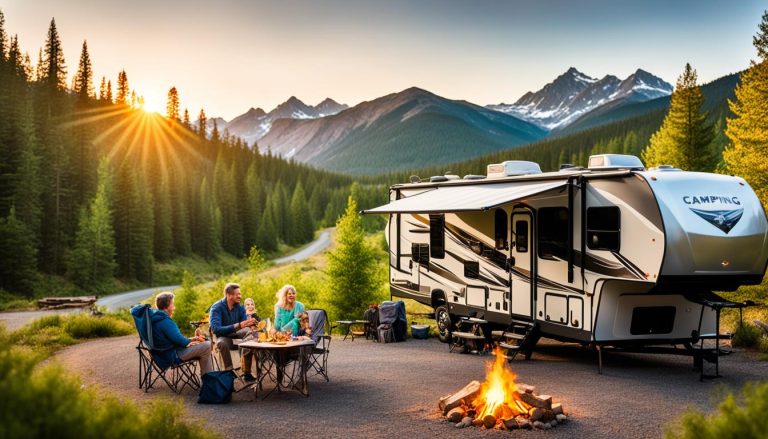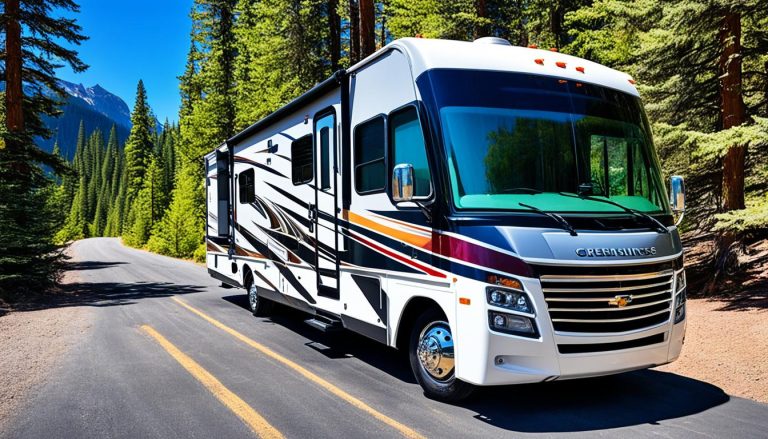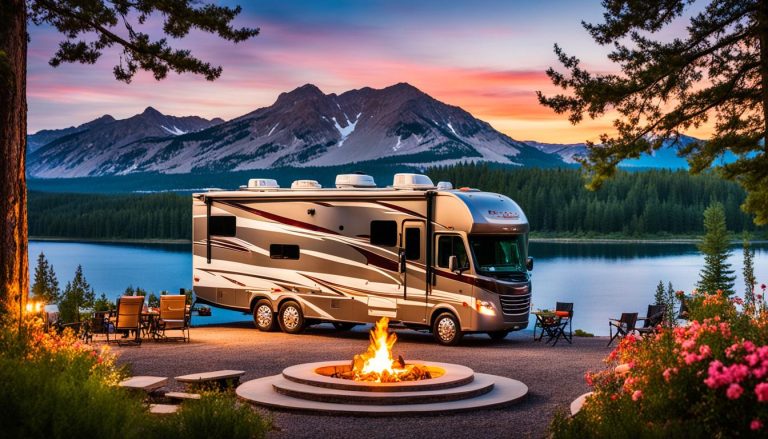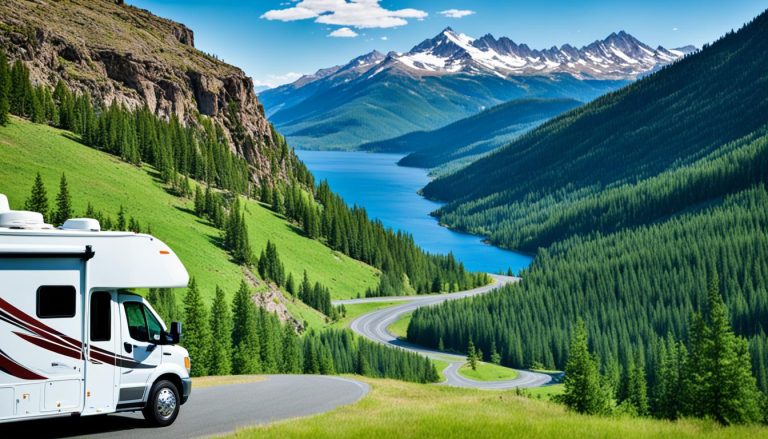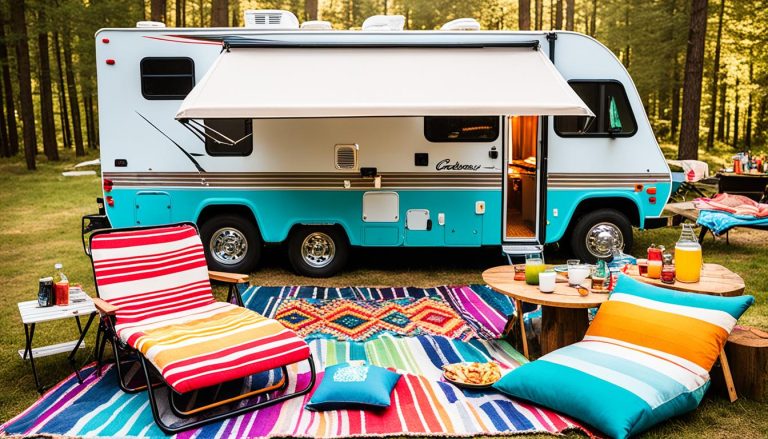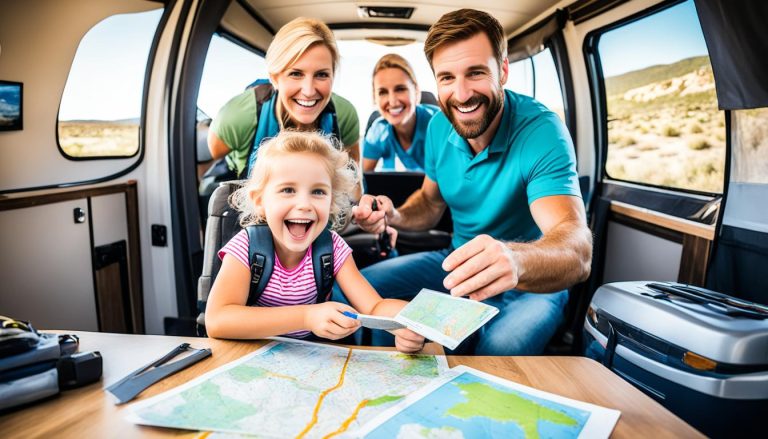Essential RV Rental Safety Tips for Your Trip
gorvlifestyle.com and its partners may earn a commission if you purchase a product through one of our links
For many travelers, the call of the open road and the allure of a self-paced adventure beckon them to the world of RVing. However, the road to exploration and freedom is best navigated with a strong foundation of RV rental safety knowledge. Whether you’re a seasoned camper or a first-timer, understanding RV safety precautions is crucial for a trip free from mishaps. This guide will embark on a journey through indispensable RV rental tips, ensuring your mobile retreat is both enjoyable and secure.
Key Takeaways
- Acclimate to the RV’s size and handling through practice before your trip
- Stay informed on the RV’s height and weight limits to prevent accidents
- Maintain a balanced load to ensure safe navigation and minimize wear
- Conduct a detailed pre-trip inspection to avoid unforeseen issues
- Keep abreast of travel conditions and weather for a smooth journey
- Secure a packing checklist that includes essential emergency items
Mastering the Basics Before You Hit the Road
For countless adventurers, there’s an undeniable allure to hitting the open road in a home-on-wheels. However, when it comes to RV rental essentials, grasping the basics is non-negotiable for ensuring safety. Initiating your journey in a spacious locale, take the helm and familiarize yourself with maneuvering, anchoring in ideal parking spots, and being ever-aware of those deceptive blind spots. This ritual is paramount to commandeering an RV like a seasoned travel captain.
Gaining intimate knowledge of your rental’s proportions is vital. This demands a disciplined observation of height, length, and weight restrictions to evade the risk of tire tragedy and structural scrapes. Equally essential is a proficient command over the RV’s expandable slides, the subtleties of a septic system, and culinary quarters, which safeguards against the commonplace roadside debacle.
To consolidate your pre-departure preparation, an RV rental checklist is indispensable. With a focus on every detail, from fundamental utensils to emergency gear, those seemingly trivial items will underpin a smooth expedition.
| Checklist Item | Description | Notes |
|---|---|---|
| Driver’s Comfort Kit | Essentials for the pilot: sunglasses, gloves, and supportive seating | Ensure a comfortable drive to reduce fatigue |
| Navigation Toolkit | Updated GPS unit, maps, and campground directories | Stay on course and aware of your surroundings |
| Kitchen Provisions | Utensils, cookware, cleaning supplies | Organized for quick access and efficient meal prep |
| Eco-Friendly Gear | Biodegradable soaps, solar chargers, reusable bags | Travel responsibly, leaving a minimal ecological footprint |
| Safety Equipment | Fire extinguisher, first-aid kit, roadside assistance gear | Prepared for any mishaps or emergencies |
As you meticulously tick off items on your renting checklist, harmonize excitement with vigilance. By marrying preparedness with wisdom, you encode security into your mobile retreat, ensuring an odyssey where marvels unfold safely within the embrace of your rolling sanctuary.
Safety tips for renting an RV
Embarking on an RV adventure comes with the responsibility to follow safe RV practices, ensuring that your journey is as secure as it is enjoyable. When renting an RV, the complexity of the vehicle demands a proactive approach to ensure safety on the road. From understanding the unique handling characteristics of a larger vehicle to ensuring that every passenger is secure, safety should always be at the forefront.
Driving an RV is vastly different from driving a standard car, and it requires the driver to adopt specific strategies. These include:
- Anticipate more significant stopping distances, which will mean slowing down sooner than usual.
- Provide ample space when making lane changes, as your visibility and maneuverability are different in an RV.
- Plan your stops to be at least 20% longer than usual to accommodate for the additional set-up and breakdown time associated with RVs.
- Balance the weight distribution evenly within the RV for optimal handling and to reduce uneven wear on your tires.
- Secure all passengers with seatbelts, and ensure children are in forward-facing seats to prevent distractions and enhance protection.
- Take regular breaks to maintain alertness and minimize driver fatigue, a critical factor in prolonged driving conditions.
Putting these practices into action will greatly contribute to a secure and delightful RV experience. Below is a summary that highlights these crucial practices:
| Safe Practice | Description | Benefit |
|---|---|---|
| Longer Stopping Distances | Anticipate and plan for increased stopping distances due to the size and weight of the RV. | Prevents collisions and allows for safer driving conditions. |
| Ample Space for Maneuvering | Give yourself more space for lane changes and turns. | Reduces risk of sideswipe accidents and improves road safety. |
| Extended Stop Times | Expect and plan for stops to take longer than when driving a car. | Allows for thorough checks and setups, ensuring everything is secure. |
| Even Weight Distribution | Constantly monitor and adjust cargo to balance weight evenly across the RV. | Enhances stability and handling, prolongs tire life. |
| Child Seat Safety | Use forward-facing seats for children and ensure all passengers are belted. | Maximizes protection for younger passengers and reduces distractions. |
| Regular Driving Breaks | Implement frequent stops to reduce fatigue on long drives. | Keeps the driver alert and responsive, decreasing the risk of accidents. |
Remember, safe RV practices not only protect you and your passengers but also contribute to the safety of everyone on the road. By adhering to these guidelines, you can look forward to a journey that is filled with wonderful memories rather than preventable mishaps.
Understanding Your RV Rental’s Features
Embarking on an RV adventure offers a blend of freedom and comfort but requires understanding the unique features of your mobile accommodation. Getting to know your RV’s various functions and capabilities is not only crucial for convenience; it’s a constituent part of the RV safety guidelines. RVs come with a variety of features that might differ from what most drivers are accustomed to in their regular vehicles. These differences often entail a larger turning radius, more considerable blind spots, and specific processes for activating certain equipment or amenities.
Many RV rental companies provide orientation materials or sessions to help renters familiarize themselves with their temporary homes on wheels. Such orientations can be pivotal in ensuring safe and delightful journeys. Below, we have tabulated some common RV features alongside considerations and tips to bear in mind, aiming to make your acclimation period smooth right from the start of your getaway.
| RV Feature | Explanation | Important Considerations |
|---|---|---|
| Turning Radius | Larger than most passenger vehicles. | Allow more room for turns; practice turns in a safe space prior to trip. |
| Blind Spots | Extended blind spots due to vehicle length. | Utilize mirrors correctly; consider additional blind spot mirrors or a camera system. |
| Leveling System | Ensures RV stability when parked. | Understand manual vs. automatic systems; confirm level before extending slides. |
| Slide-Out Rooms | Expand living space; require a clear area to extend. | Ensure area is free of obstacles; check for secure locking before moving RV. |
| Awnings | Provides shade and outdoor living space. | Retract during windy conditions and before departure; clean and dry to prevent mold. |
| Braking System | May differ due to RV weight and size. | Anticipate longer stopping distances; ensure the braking system is well maintained. |
| Septic and Freshwater Systems | Essential for sanitation and hygiene. | Learn proper use and disposal techniques; monitor levels daily. |
By delving into each feature with an eagerness to learn, Renters can transform potential challenges into seamless aspects of their travel experience. Adhering to these RV safety guidelines will lead not only to a more delightful journey but also to a safer one for everyone on the road.
Pre-Trip Preparation: Your RV Safety Checklist
Before embarking on your journey, prioritizing RV rental safety can safeguard you and your travel companions. By taking a systematic approach to pre-trip preparations, you ensure a smoother and safer trip. Follow this detailed safety checklist to make sure your RV is road-ready and to prevent any mishaps along the way.
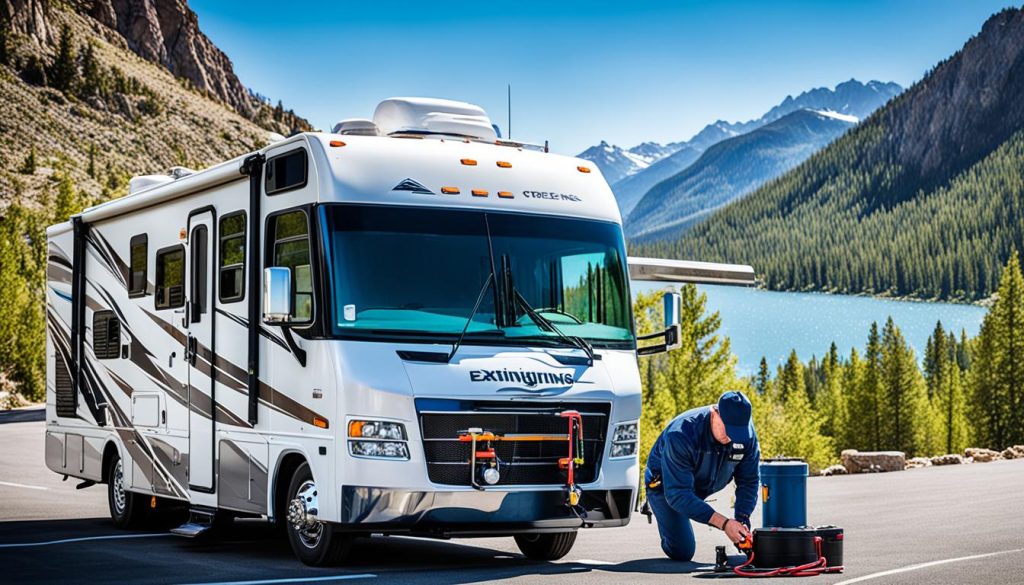
| Checklist Item | Description | Checked |
|---|---|---|
| Secure all doors | Make sure all interior and exterior doors are locked and secure. | |
| Retract steps and awnings | Steps should be fully retracted and awnings stowed to prevent damage or accidents while driving. | |
| Check tow bars and safety cables | Ensure tow bars are locked in place and safety cables are properly attached. | |
| Turn off stove and oven burners | Verify that all burners are turned off to prevent fire hazards. | |
| Disconnect all cords | Electrical, water, and sewage cords should be disconnected and stored safely. | |
| Fluid levels check | Check engine oil, transmission fluid, coolant, and other necessary fluid levels. | |
| Tire air pressure | Ensure tires are inflated to the recommended pressure for optimal safety and fuel efficiency. | |
| Lighting systems | Confirm that headlights, brake lights, turn signals, and any other external lights are functioning. | |
| Secure all luggage | Stow and secure luggage to prevent shifting during travel which can cause imbalances. | |
| Portable grill safety | Ensure any portable grills are fully extinguished and cooled down before stowing away. |
By meticulously going through this RV safety checklist, travelers can set out on their adventures with peace of mind, knowing that essential safety measures have been addressed. Diligently following RV rental safety guidelines not only protects the passengers but also extends the lifespan and quality of the RV’s performance on the road.
Evaluating Road Conditions and Weather Forecasts
Embarking on an adventure in an RV can lead to memorable experiences, but the journey must begin with a thorough evaluation of the road conditions and weather forecasts. Understanding the meteorological elements can prevent mishaps and ensure adherence to RV safety guidelines. Continuous monitoring of weather patterns is not just recommended; it’s a necessity for responsible RV driving.
Road conditions can alter dramatically with weather changes. For example, an unexpected thunderstorm could lead to flooded roads, while a sudden drop in temperature overnight might result in black ice that’s invisible to the eye but perilous for any vehicle, more so for the less nimble RV. Heed the RV rental tips from seasoned travelers and stay informed about local weather and travel advisories in the regions you plan to visit.
A prudent traveler is always one step ahead, planning alternative routes and allowing for flexible travel dates. Below is a table summarizing the potential weather conditions to be aware of and suggested precautions to take. This guide assists RV renters in recognizing risks and making informed decisions to safeguard their trip.
| Weather Condition | Potential Hazards | Precautions |
|---|---|---|
| Rain | Reduced visibility, hydroplaning | Reduced speed, increased following distance |
| Snow | Ice, decreased tire traction | Chains for tires, frequent breaks to remove snow build-up |
| High Winds | Difficulty steering, risk of tipping | Staying off the road, securing loose items |
| Fog | Severely reduced visibility | Using fog lights, driving at a cautious pace |
| Extreme Heat | Overheating engine, tire blowouts | Regularly checking coolant and tire pressure |
Remember, the key to a successful RV journey lies in the balance between adventure and safety. Always be prepared to adjust your plans according to the road and weather conditions encountered. Follow these RV rental tips and RV safety guidelines to make your trip an enjoyable and incident-free experience.
On the Road: Navigating with Care and Caution
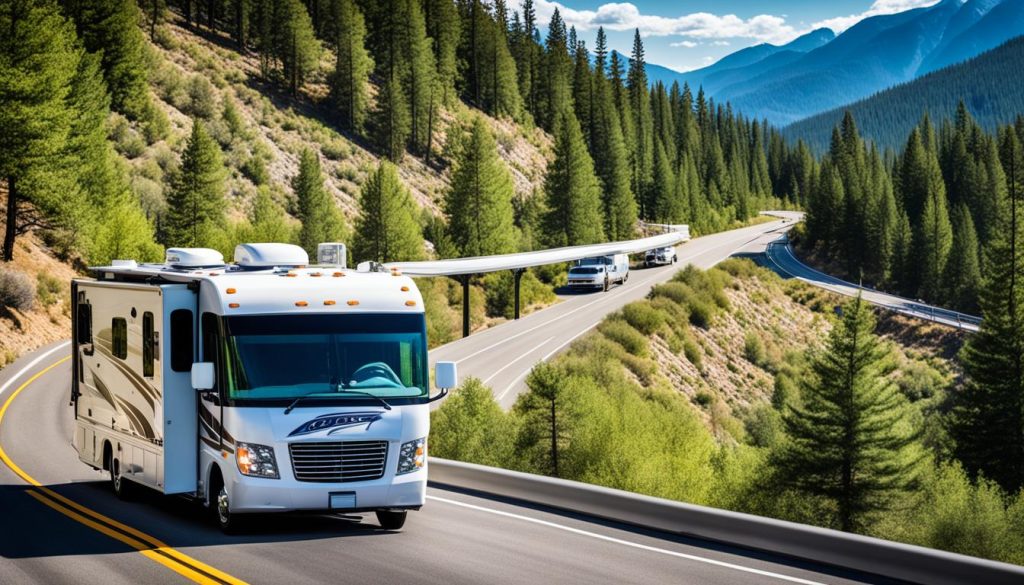
Moving an RV down winding roads and bustling highways requires a heightened sense of vigilance and adherence to RV safety recommendations. The journey is not just about reaching the destination, but ensuring a secure passage for all aboard. Diligent drivers recognize the need for greater distance between their RV and other vehicles, accommodating their extended braking time and ensuring plenty of space for safe lane changes.
When it comes to turns, the mantra is ‘slow and steady’. Following Safe RV practices, drivers are advised to approach turns at cautious speeds, making use of mirrors and cameras to guide the larger vehicle around corners safely. It’s a ballet of patience and precision that can prevent accidents and preserve the integrity of other motorists’ journeys as well.
Weather is an unpredictable companion on any road trip, and its impact on an RV can be significantly more severe than on smaller vehicles. Below is a guide to help RV drivers manage different weather conditions:
| Weather Condition | Recommendation |
|---|---|
| High Winds | Reduce speed, steer steadily, and be prepared for gusts. |
| Heavy Rain | Increase following distance, use headlights, and navigate standing water with caution. |
| Snow and Ice | Use tire chains if necessary, travel only during daylight, and keep a slow, constant speed. |
| Fog | Utilize fog lights if available, drive with low beam headlights, and maintain a conservative pace. |
In summary, driving an RV safely is an exercise in foresight and prudence. Respecting the size of one’s vehicle, the conditions of the road, and the vagaries of weather all contribute to a journey that is not merely survived but thoroughly enjoyed. Heed the call to drive cautiously, and the road will open up as a friend rather than a foe.
The Importance of Regular Breaks During Long Drives
When undertaking an excursion in a rental RV, the exhilaration of exploration is often interspersed with lengthy stretches of driving. To ensure RV rental safety recommendations are met, it’s vital for drivers to incorporate regular stops into their travel itinerary. Such pauses on the journey are not merely an opportunity to stretch and refresh but are integral to maintaining sharp focus and minimizing the likelihood of accidents stemming from weariness or physical stiffness.
Taking regular breaks is about more than just rest—it’s about reassessing vehicle conditions, reevaluating your course, and allowing all passengers to regroup, both mentally and physically. A stop as brief as fifteen minutes every two hours can significantly bolster alertness and contribute to overall trip well-being.
Regularly scheduled stops are a simple yet effective strategy for enhancing road safety and the overall enjoyment of the RV experience. Do not underestimate the power of a pause—encourage it, embrace it, and make it an inseparable part of your journey.
Below is a suggested breakdown of activities to undertake during each break, ensuring every stop is utilized effectively:
| Time Elapsed | Recommended Activity | Safety Benefit |
|---|---|---|
| Every 1 Hour | Quick body stretch and posture adjustment | Reduces muscle tension and supports circulation |
| Every 2 Hours | Vehicle condition check (tire pressure, fluid levels) | Prevents mechanical issues and ensures vehicle integrity |
| Every 3 Hours | Hydration and light snacks | Keeps energy levels steady and prevents dehydration |
| Every 4 Hours | Comprehensive stretch and brief walk | Enhances alertness and prevents drowsiness |
| Every Refuel | Check mirror angles and cabin organization | Ensures that cargo remains secure and optimizes visibility |
In conclusion, regular breaks are crucial for a safer and more enjoyable traveling experience in a rented RV. These interludes enable drivers and passengers alike to return to the road with renewed energy and attention—crucial components to making memories that last a lifetime on the open road.
Setting Up a Safe and Secure Campsite
Arriving at your destination means it’s time to create a safe haven amidst nature’s beauty. Ensuring your RV camping safety extends from road to rest, with each step crucial for a secure stay. Prepare a solid foundation for your temporary home and acquaint yourself with the environment while keeping communication channels open for any challenges that may arise.
Stabilizing Your RV at the Destination
To ensure RV rental safety, stabilize your RV as soon as you reach your campsite. Deploy stabilizing jacks, level your RV, and check that all slides and canopies are securely set to prevent accidental movement or tilting, which could potentially lead to injury or damage to your vehicle.
Local Knowledge: Being Aware of Your Surroundings
RV safety precautions include being well-informed about your immediate environment. Learn about native wildlife, potential weather hazards, and any unique landscape features. This knowledge can help prevent encounters with dangerous animals and inform decisions during changing weather conditions.
Always Have a Communication Plan
In areas where cell service is unreliable, your RV camping safety plan should include alternative communication methods. Equip your group with walkie-talkies, or consider renting a satellite phone. This ensures that you can reach out for help or stay in contact with your group, should anyone venture further from the campsite.
Above all, always have an emergency action plan that includes a meeting point, a stocked first-aid kit, food and water supply, and an understanding of the nearest exits from your campsite. Preparedness is key to a safe camping experience.
| RV Safety Aspect | Preparation Steps | Emergency Supplies |
|---|---|---|
| Stabilization | Use jacks and levelers; Secure expansions | N/A |
| Local Wildlife | Research and educate all travelers | Animal repellant, informative guides |
| Weather Awareness | Monitor forecasts, identify shelters | Weather radio, sturdy clothing |
| Communication | Establish check-in times, designate meet-up locations | Satellite phone, walkie-talkies |
| Emergency Procedures | Practice drills, inform on exits | First-aid kit, non-perishable food, water |
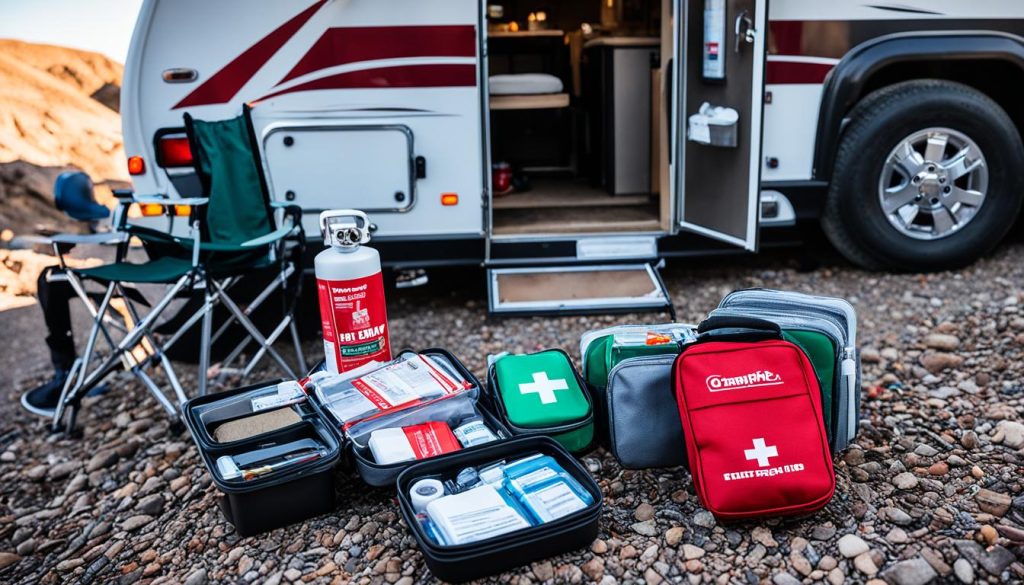
Emergency Readiness: Plans for Unpredictable Situations
Adventuring in an RV provides a unique opportunity to explore the great outdoors, but it also demands vigilance and preparedness for unexpected events. Whether it’s a medical emergency, a power outage or a natural disaster, being ready can mean the difference between a minor inconvenience and a crisis. Building an emergency action plan and ensuring that your RV is equipped with the necessary tools and supplies forms a critical part of any Renting an RV checklist and adherence to RV safety guidelines.
Creating an Action Plan for Emergencies
Constructing a detailed plan calls for consideration of potential scenarios from health-related incidents to mechanical failures. This plan should include steps for responding to such events, a list of emergency contacts, and designated meeting points for all travelers in case of separation.
Equipping Your RV with Necessary Tools and Supplies
Stocking your RV for readiness is not just about packing extra snacks for the road. It’s about preparing for scenarios that we hope never happen. From first aid kits to emergency food and water, the equipment onboard could significantly impact the outcome of an emergency situation. It is equally important to educate all passengers, including children, on how to use these tools effectively and safely, ensuring everyone can respond proficiently.
| Category | Essentials | Quantity |
|---|---|---|
| First Aid | Comprehensive first aid kit | 1 |
| Food and Water | Non-perishable food items and bottled water | Enough for 3 days per person |
| Clothing and Shelter | Extra clothing, blankets, and emergency shelter | Varies |
| Tools | Multi-tool, flashlight, extra batteries, emergency whistle | 1 set |
| Communication | Fully charged cell phone with backup power sources, two-way radios | 1 per person |
Safe Practice Leads to Memorable Adventures
Embarking on an adventure aboard a rental RV is an enriching experience that offers freedom, flexibility, and the joy of the open road. Yet, the cornerstone of any successful journey is the unwavering commitment to safety. Heeding essential safety tips for renting an RV and being well-versed in RV rental essentials can significantly reduce risks and lead to rewarding, lasting memories. From the careful crafting of a trip plan to the vigilant execution of road safety protocols, every step taken towards preparation and precaution serves as a building block for not just a trip, but an adventure of a lifetime.
When it comes to operating the RV, meticulous attention to the vehicle’s unique features and requirements will pay dividends in travel tranquility. Taking advantage of RV rental essentials like pre-trip safety courses – available through both digital platforms and in-person sessions – empowers travelers with knowledge on vehicle maintenance and handling. This education goes beyond the basics, delving into the nuances of safe camping practices and the seasoned management of unexpected road conditions.
In summary, infusing safe practice into every aspect of the RV rental journey is integral for a delightful and incident-free expedition. Whether you’re a first-timer or a seasoned traveler, embracing these practices transcends mere preparation – it cultivates an environment where peace of mind and the thrill of discovery coexist harmoniously. As adventurers take to the highways and byways, they can be assured that safety, the true compass of travel, will guide them to experiences that resonate well beyond the last mile.

